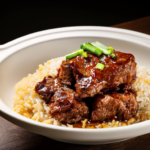Exploring the Flavors of Shandong: Classic Braised Prawns with Soy Sauce
Introduction:
Welcome to our culinary journey through Shandong cuisine, one of China’s eight major cuisines. Known for its simplicity, freshness, and hearty flavors, Shandong cuisine has a long history and is deeply rooted in traditional Chinese cooking techniques. One of the most iconic dishes from this region is Braised Prawns with Soy Sauce, a dish that showcases the exquisite balance between rich umami and delicate seafood. In this article, we will delve into the origins of this classic dish, explore the ingredients, and guide you through the step-by-step process of preparing this delectable meal.
The History and Significance of Braised Prawns with Soy Sauce
Shandong cuisine, also known as Lu cuisine, originated in the Shandong province of northern China. It is characterized by its use of fresh ingredients, minimal seasoning, and the emphasis on the natural flavors of the ingredients. Braised Prawns with Soy Sauce is a prime example of this philosophy. The dish dates back centuries, and it was initially prepared using local prawns caught in the coastal waters of Shandong. Over time, the recipe has been refined, but its core principles remain unchanged.
This dish not only represents the culinary prowess of Shandong chefs but also reflects the cultural significance of seafood in the region. The coastal areas of Shandong have been home to fishing communities for millennia, and their culinary traditions have been passed down through generations. Today, Braised Prawns with Soy Sauce continues to be a popular choice among both locals and tourists, offering a taste of authentic Shandong cuisine.
Ingredients and Preparation
To prepare this dish, you will need high-quality ingredients that reflect the essence of Shandong cuisine. Below is a detailed list of ingredients and preparation steps:
Ingredients:
- Large prawns (about 8-10 per person)
- Soy sauce (preferably light soy sauce for a milder flavor)
- Scallions (green onions), finely chopped
- Ginger, thinly sliced
- Garlic, minced
- Sugar (optional, for balancing the saltiness of the soy sauce)
- Sesame oil (for finishing)
- Water or stock (for braising)
- Vegetable oil for frying
Preparation Steps:
- Prepping the Prawns: Start by cleaning the prawns thoroughly. Remove the heads, shells, and devein them if necessary. Pat them dry with paper towels to ensure they cook evenly.
- Frying the Prawns: Heat a generous amount of vegetable oil in a large skillet over medium-high heat. Once the oil is hot, carefully add the prawns and fry until they turn pink and crispy on the outside. Remove the prawns from the pan and set them aside.
- Braising the Prawns: In the same skillet, reduce the heat to medium and add the ginger, garlic, and scallions. Sauté for about 2 minutes until fragrant. Then, pour in the soy sauce and sugar (if using). Stir well to combine.
- Adding Liquid: Add enough water or stock to cover the prawns. Bring the mixture to a simmer and let it cook for about 10 minutes, allowing the flavors to meld together.
- Finishing Touches: Once the prawns are tender and the sauce has thickened slightly, remove the skillet from the heat. Drizzle with sesame oil and garnish with additional scallions. Serve immediately.
Cooking Techniques and Tips
One of the key aspects of Shandong cuisine is the careful balance between simplicity and depth of flavor. Here are some tips to ensure your Braised Prawns with Soy Sauce turns out perfectly:
- Choose Fresh Ingredients: The quality of the prawns is crucial. Opt for large, fresh prawns that are firm and plump. This ensures a better texture and more robust flavor.
- Control the Heat: When frying the prawns, make sure the oil is hot enough to sear the prawns without overcooking them. This will give them a golden crust while keeping the inside juicy.
- Balance the Soy Sauce: Shandong cuisine emphasizes the natural flavors of the ingredients, so use soy sauce sparingly. Light soy sauce works best here, as it provides a mild yet rich umami flavor without overpowering the prawns.
- Simmer Gently: When braising the prawns, keep the heat at a gentle simmer. This allows the prawns to absorb the flavors of the soy sauce and other aromatics without becoming mushy.
- Finish with Sesame Oil: A drizzle of sesame oil at the end adds a nutty aroma and enhances the overall flavor profile of the dish.
Serving Suggestions
Braised Prawns with Soy Sauce is typically served as part of a larger Shandong-style meal, often accompanied by steamed rice, stir-fried vegetables, and perhaps a side of dumplings. However, it can also stand alone as a main course, especially when paired with a light salad or pickled vegetables.
For a truly authentic experience, consider serving this dish with a bowl of clear broth soup, such as Shandong-style fish head soup, which complements the richness of the prawns. Alternatively, a simple cucumber salad with sesame dressing can provide a refreshing contrast to the savory prawns.
Nutritional Value and Health Benefits
Braised Prawns with Soy Sauce is not only delicious but also offers several health benefits. Prawns are an excellent source of lean protein, omega-3 fatty acids, and essential vitamins and minerals like vitamin B12, selenium, and zinc. These nutrients contribute to heart health, immune function, and cognitive well-being.
The soy sauce used in this dish is a fermented product that contains beneficial bacteria and antioxidants. However, it is important to note that soy sauce is high in sodium, so moderation is key. If you’re watching your salt intake, you can opt for low-sodium soy sauce or reduce the amount used in the recipe.
Conclusion
Exploring the flavors of Shandong cuisine through dishes like Braised Prawns with Soy Sauce offers a glimpse into the rich culinary heritage of this region. By following the steps outlined in this article, you can recreate this classic dish at home and savor the harmonious blend of umami-rich soy sauce and succulent prawns. Whether you’re a seasoned chef or a beginner in the kitchen, this dish is sure to impress with its simplicity and depth of flavor.
We hope this guide has inspired you to dive deeper into the world of Shandong cuisine. Stay tuned for more recipes and culinary adventures!


